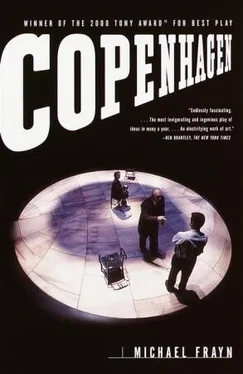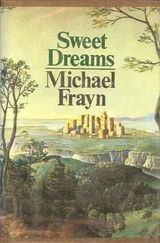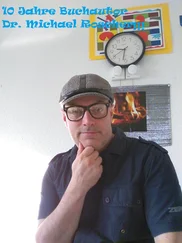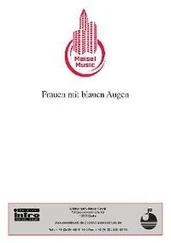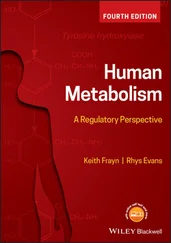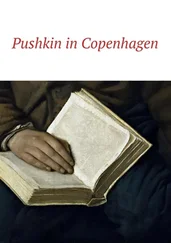The calculation of the critical mass is not the only thing that Heisenberg got wrong that night. Even when he revealed to Hahn that he understood how the critical mass could be reduced by the use of a reflective shield he suggested a material, carbon, that would have had the opposite effect to the one intended. Carbon is a good moderator for a reactor, and Heisenberg’s proposing it for the ‘tamper’ in a bomb, says Bernstein, ‘shows he was thinking like a reactor physicist, which, for the last two years, he was.’
These were of course Heisenberg’s first thoughts off the top of his head in the wake of Hiroshima. A week later, with the help of what few details the newspapers had given of the two bombs, Heisenberg offered all his fellow-internees a lecture in which he presented a complete and considered account of how the Allies had done it. The inclusion in the lecture of quite fundamental matters, argues Powers, together with the questions which his hearers asked, make it clear that it was all news to everyone present except his closest associates. ‘What the Farm Hall transcripts show unmistakably,’ he says, ‘is that Heisenberg did not explain basic bomb physics to the man in charge of the German bomb program [Gerlach] until after the war was over.’ They ‘offer strong evidence that Heisenberg never explained fast fission to Gerlach.’ At the end of the lecture, says Powers, ‘the German scientists, given a second chance, would have been ready to start building a bomb.’
Bernstein sees the lecture very differently. He demonstrates that Heisenberg’s exposition is still marred by quite fundamental misconceptions. Heisenberg now seems to have ‘the first inkling’ of how to calculate the critical mass (though he still does the arithmetic wrong), but is not much nearer to the practicalities of building a bomb than his audience. What the novelty of a lot of this material suggests to Bernstein is simply that communications between the different sections of the German project were very poor.
As a non-scientist I can’t offer any opinion on the physics. To my eyes, I have to say, Heisenberg does seem to have come a remarkably long way in a week — if, that is, he was starting more or less from scratch. And he surely must have been. It’s really not plausible that he hadn’t recollected more by this time if he actually had done the work. The conclusion seems to me inescapable: he hadn’t done the calculation. If he had kept the fatal knowledge of how small the critical mass would be from anyone, as Powers argues, then it was from himself.
*
In the end, it seems to me, your judgment of Heisenberg comes down to what you make of his failure to attempt that fundamental calculation. Does it suggest incompetence or arrogance, as his detractors have claimed? It’s possible. Even great scientists — and Bernstein agrees that Heisenberg was one of them — make mistakes, and fail to see possibilities that lesser men pick up; Heisenberg accepted that he had made a mistake in the formulation of uncertainty itself. And I think we have to accept Bernstein’s judgment that, although he was the first person to be able to grasp the counter-intuitive abstraction of quantum mechanics, he was not so good at the practicalities of commonsense estimates and working arithmetic.
Or does the failure suggest something rather different? An unconscious reluctance to challenge the comforting and convenient assumption that the thing was not a practical possibility? Comforting and convenient, that is, if what he was trying to do was not to build a bomb. Is it all part of a general pattern of reluctance, as the first and more plausible part of Powers’s thesis suggests? If so, you might wonder whether this reluctance was a state definite enough to be susceptible of explanation. Heisenberg was trapped in a seamless circle which explains itself: he didn’t try the calculation because he didn’t think it was worth doing — he didn’t think it was worth doing because he didn’t try it. The oddity, the phenonomenon that requires explaining, is not this non-occurence but its opposite — the escape of Frisch and Peierls from that same circle. It seems almost like a random quantum event; in which case, of course, it is no more explainable than its not happening.
After the war, certainly, Heisenberg was not just passively reluctant about any military application of nuclear power, but very actively so. In the 1950s, when there was a proposal to arm Federal Germany with nuclear weapons, he joined forces with Weizsäcker and others to fight a vigorous campaign that entirely and permanently defeated it.
There is also one small piece of evidence about his attitude during the war that Powers rather curiously doesn’t comment on: the question of the cyclotron.
At the crucial meeting between Heisenberg and Speer in 1942, which seems finally to have scuppered all possibility of a German bomb, Heisenberg is reported to have emphasised the need to build a cyclotron. A cyclotron could have been used, as the cyclotrons in America were, for isotope separation, the great sticking-point in the German programme. In the account of this meeting in his memoirs Speer says: ‘Difficulties were compounded, Heisenberg explained, by the fact that Europe possessed only one cyclotron, and that of minimal capacity. Moreover, it was located in Paris and because of the need for secrecy could not be used to full advantage.’ Powers mentions this, but does not go on to the obvious corollary: that if Speer’s recollection is accurate, then Heisenberg was plainly lying, because he knew perfectly well that there was a second cyclotron to hand — at Bohr’s institute in Copenhagen. This would suggest that his apparent anxiety to lay his hands on a machine that might actually separate some U235 was not quite what it seemed. Or, at the very least, that he placed Germany’s war aims below his desire to protect Bohr’s institute.
Perhaps Speer is simply wrong. It seems uncharacteristic of Heisenberg to have risked such a blatant falsehood, and he makes no mention of it in his own accounts of the meeting. All the same, when he went back to Copenhagen in 1944, after Bohr had fled, to adjudicate a German proposal to strip the institute of all its equipment, presumably including the cyclotron, he seems to have contrived to leave it even then still in Danish hands.
*
One of the forms of indeterminacy touched upon in the play is the indeterminacy of human memory, or at any rate the indeterminability of the historical record. There are various examples which I left out, for fear of making the play even more tangled than it is. Some, such as the difficulties about the amazingly realistic figure for the critical mass that von Ardernne recollected being given by Heisenberg and Hahn in 1941, I have already mentioned in this Postscript. There were others. A minor one concerns whether there were two ships sent to load the Jews of Copenhagen for deportation, as some witnesses recall, or a single one (named as the Wartheland). A more significant point of dispute is the drawing which Heisenberg did or didn’t make for Bohr during their meeting in 1941.
According to Hans Bethe, who was one of the team at Los Alamos, Heisenberg drew a rough sketch to show Bohr the work that was being done in Germany. Bohr evidently took it to Los Alamos with him when he went, because Bethe (and others) recall it being passed around at a meeting there. Bethe told Powers that Bohr believed it represented a bomb; but the consensus of opinion at the meeting was that it was a reactor. However, Aage Bohr, Niels’s son, a physicist himself (and another Nobel prizewinner), who was with his father in Copenhagen during Heisenberg’s visit, and with him again in Los Alamos, was absolutely insistent that there was no drawing.
If the story is true it might help to explain Goudsmit’s insistence, in the teeth of the evidence from Farm Hall, that Heisenberg couldn’t tell the difference between a reactor and a bomb. It would certainly cast doubt on Heisenberg’s recollection that the entire discussion with Bohr in 1941 took place during the walk, and that Bohr broke off the conversation almost as soon as it was broached. It seems improbable to me that Heisenberg would have risked putting anything down on paper, and if even so he had then I can’t see why he didn’t seize upon it after the war, to support his claim that he had hinted to Bohr at the German research on a bomb. I suppose it’s possible that Bohr made the sketch himself, to illustrate to his colleagues at Los Alamos what he thought Heisenberg was getting at, but the truth of the matter seems to be irretrievable.
Читать дальше
